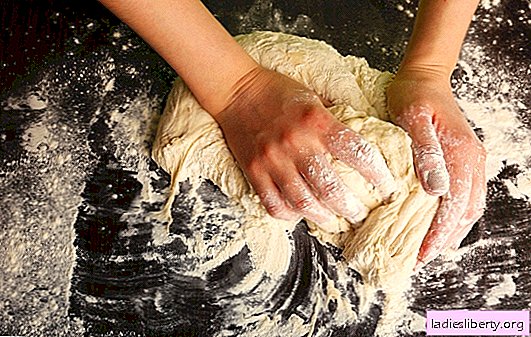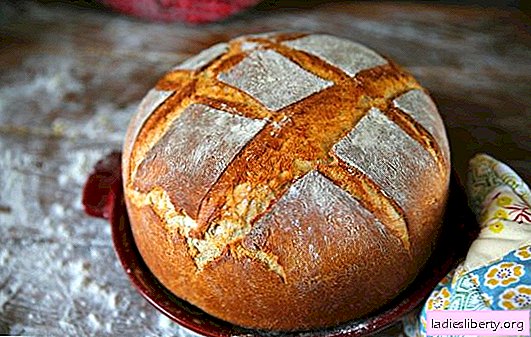
Yeast dough is soft, tender, rises well, and baking pleases with good taste. But this is ideal. This does not always happen. Why is the dough sometimes tough, falls off, baking stale quickly, do you get very heavy rolls and pies?
Mistake One: Cold Food and Room
Yeast dough rises only in a warm environment.
For this reason, the ingredients for cooking need to be heated. Flour and bulk products are simply left at room temperature so that they lie. Liquids are specially heated to 38-45 degrees.
You can also spoil the dough if you run the yeast into hot water.
They will simply die, possibly partially. The dough will rise for a long time, it will turn out to be heavy, dense, baking will not please with softness and size. After kneading, the dough is left in a warm place, but no longer heated, this can not be done. They must be covered with a breathable fabric on top, so that the mass does not become crusty.
Mistake Two: Poor Yeast
Yeast is dry and live pressed, usually in briquettes. Recipes indicate the desired type. Now most often used is dry yeast. Regardless of the type of product, it is important to check its expiration date. Expired yeast has low lift. If the dough does not rise, then this may be the problem. You can pre-check the suitability of the yeast.
How to check yeast:
- Mix the required amount of yeast with the prescribed amount of liquid. Add a little sugar, you can take from the recipe, but not the whole norm.
- We introduce a few spoons of flour. It should be a talker, like a pancake dough.
- Leave in a warm place for 15-30 minutes.
- If a good foam appeared on the surface, the talker rose and increased in size, then the yeast is of good quality. Add the remaining products, make the dough.
- If the talker does not increase or rises weakly, then you can add more yeast and also knead the dough.
- If the talker has not changed, then the yeast is worthless, you should not waste time on them and spoil the rest of the products.
The same talker is made to activate and accelerate fermentation. The result is a simplified pair, which significantly reduces the time of raising the dough.
Dry yeast can be replaced with live yeast, for this we simply increase the amount by three times. For 10 g of dry yeast, take about 25-30 g of compressed yeast. You can also change them in the opposite direction. Dry yeast has more lift, is a concentrate, moreover, it is perfectly stored and does not require special conditions. Therefore, it is increasingly they that are used in recipes.
Important! Regardless of the type of yeast, you must adhere to the recommended amount. You do not need to increase it, otherwise the test will have an unpleasant taste. If you lay less than the norm, the lifting process will be greatly delayed.
Third mistake: a lot or a little flour
No dough is made without flour. The result depends on its grade. Everyone knows that flour needs to be sifted. This eliminates litter and removes lumps. The product becomes loose and airy, but it is important not to overdo it with the quantity.
Yeast dough does not need to be hammered. Even after kneading, it should remain soft and slightly sticky. If there is a lot of flour, the baking will turn out tough, it will not rise well, it will also affect the taste.
Another mistake is small amount of flour. If the dough spreads, does not hold its shape, sticks to hands, it is difficult to work with it. In addition, the batter rises and peroxides very quickly. Such a mass is suitable only for yeast pancakes and pancakes. Cakes, rolls, loaf of it cannot be formed.
Fourth mistake: a lot of sugar or lack
Yeast dough without sugar will not work, but also it will become tasteless without salt.
Sand helps to activate the yeast, contributes to the lifting of the mass, accelerates the processes. If you knead without it, the dough can rise, but it will not brown, there will be large pores, the taste of baking will resemble ordinary bread. In pies, rolls, rolls, sugar is always added.
Another mistake when mixing homemade dough is a large amount of sugar. It turns out a heavy, dense baking. With an excess of sugar, yeast is difficult to work with, so a measure is needed in everything. Sometimes it’s better to sprinkle a bun with sugar on top than to lay a lot when kneading.
Fifth mistake: the dough has stood a little or a lot
If the yeast dough did not rise well, then it simply did not go acid. On average, he needs to stand for 2.5 to four hours. After the first rise, the dough is lowered by hand, mixed. Then let rise again. The cooler the room and the more ingredients in the composition, the more time it will take to lift.
If you cut the dough immediately after kneading, it may rise slightly in the oven, but the pastries will not please the taste.
Signs of test readiness:
- it stood for at least two hours;
- the mass rose well at least once;
- when pressed, the fossa does not recover, but remains.
Sometimes the dough peroxides. This happens if it contains a lot of yeast, the mass is too long. This cannot be fixed. You can determine the sour smell.
Also peroxidized dough itself is omitted. It loses sugar, does not brown in the oven, does not rise or does it languidly. No need to waste time on it, but a small part can be used as a sponge.
The secrets of working with yeast dough
- If you need to speed up the rise and maturation of the dough, you can add a spoonful of brandy or vodka to it when kneading.
- In addition to yeast, you can add a small amount of baking powder, one teaspoon per kilogram of flour is enough. The dough will turn out porous, soft, while the taste does not change.
- If it’s cool at home, then a bowl of dough can be put on a pan with hot water, sometimes you turn on a stove under it, and slightly heat it.
- So that the yeast dough does not stick to the dishes, you need to knead it well until smooth. You can also lightly grease the bowl with vegetable oil.
If there is a lot of salt in the dough, then it will rise poorly, besides it will turn out to taste bad. One teaspoon is enough per kilogram of flour.
The exact amount of salt depends on the baking as well as the additional ingredients. For example, in margarine it is already present.











